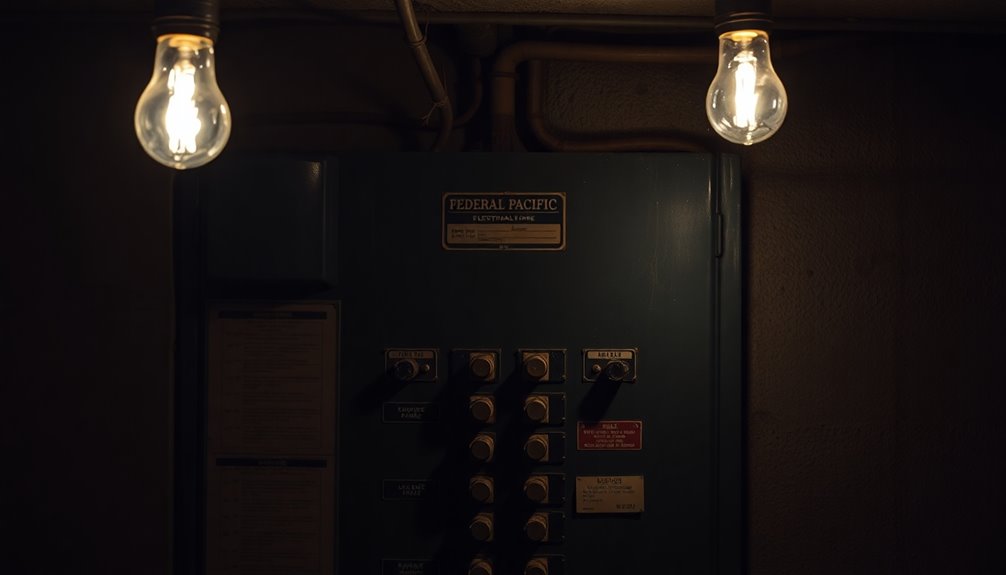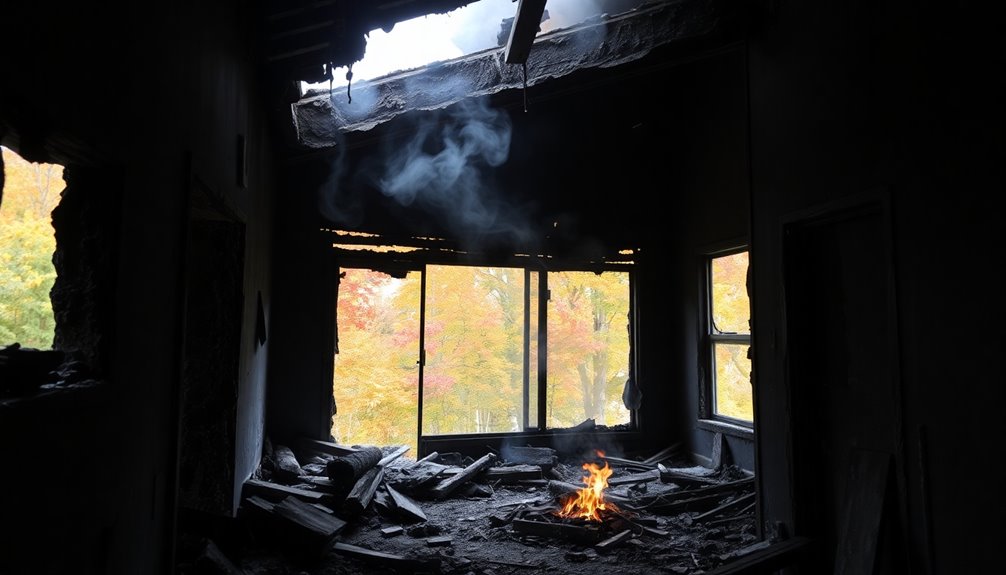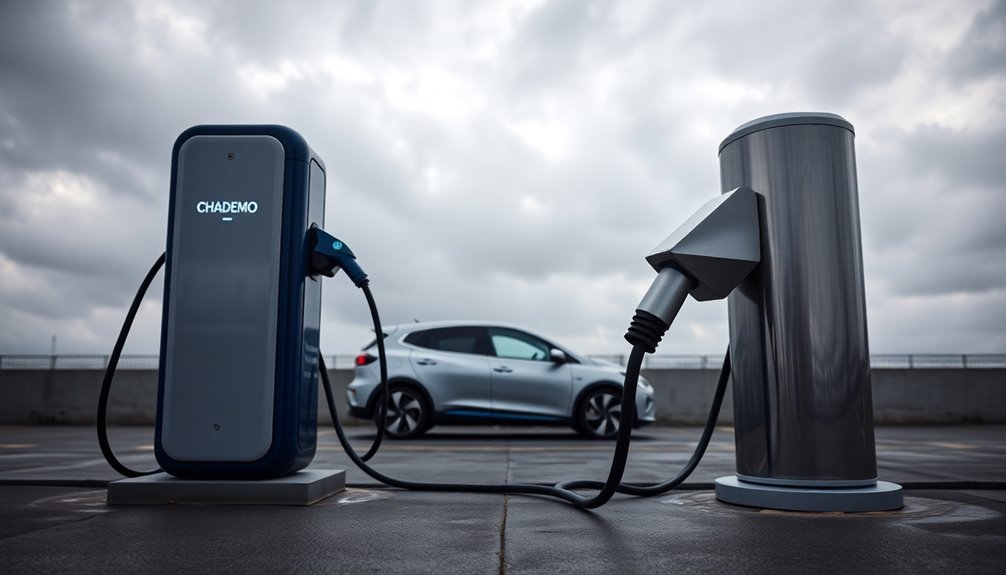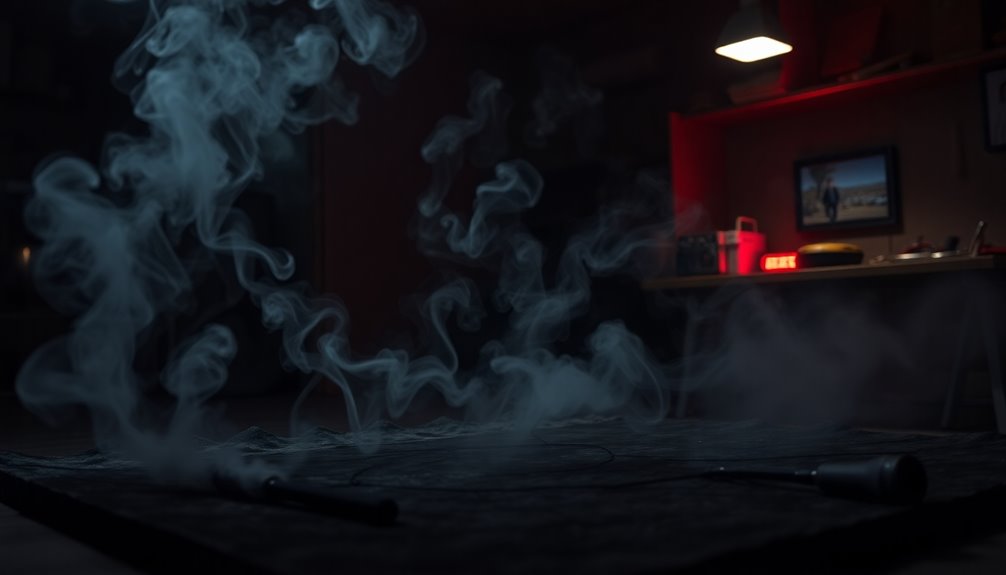Federal Pacific Electric (FPE) panels aren't technically illegal, but using them comes with serious safety concerns. These panels have a high failure rate, meaning they might not trip during an overload, which can lead to fires and property damage. They also don't meet current electrical codes, making their presence a liability for homeowners. Installing new FPE panels is against regulations, and having one could increase your insurance premiums or complicate real estate transactions. If you're unsure about your panel's safety, there's more to uncover about the risks and options available.
Key Takeaways
- Installation of new Federal Pacific Electric (FPE) panels is illegal due to safety concerns and non-compliance with current electrical standards.
- FPE panels have a high failure rate, with circuit breakers failing to trip in about 33% of cases, posing significant fire hazards.
- The Consumer Product Safety Commission (CPSC) identified dangerous faults in FPE panels, leading to increased scrutiny and safety regulations.
- Homes with FPE panels face higher insurance premiums and potential coverage denial due to their classification as high-risk by insurers.
- Upgrading FPE panels to modern alternatives is crucial for safety, compliance, and maintaining property value during real estate transactions.
Historical Context of FPE Panels

Since their inception in the mid-20th century, Federal Pacific Electric (FPE) panels have played a significant role in residential electrical systems across North America. Founded in Newark, New Jersey, in 1925, FPE initially focused on commercial and industrial markets before expanding to residential panels. The company, originally known as Federal Electric Corporation, rebranded to Federal Pacific Electric and gained popularity for its "Stab-Lok" circuit breakers.
Starting in the 1960s, FPE panels became widely installed in homes due to their affordability and ease of installation, attracting millions of homeowners across the United States and Canada. Most installations happened during suburban development booms, with FPE panels peaking in use throughout the mid to late 20th century. However, ownership changed in 1979 when Reliance Electric Co., a subsidiary of Exxon, acquired FPE. This transition led to increased scrutiny, particularly after the Consumer Product Safety Commission (CPSC) began investigating alleged safety issues with FPE circuit breakers in 1980. Although many homes still contain these panels, their faulty breakers have raised significant safety concerns, especially regarding their tendency to fail during electrical overloads. Though the investigation closed without a full verdict on safety, the legacy of FPE panels remains a topic of concern for many homeowners today.
Safety Risks and Failures

The safety risks associated with Federal Pacific Electric (FPE) panels can pose serious threats to your home and family. You need to know that these panels have a staggering failure rate, with circuit breakers failing to trip in 1 out of 4 instances. This can lead to dangerous electrical overloads and surges. The absence of a ground wire in each breaker further increases the chances of power surges and malfunctions.
You might notice fuses blowing out regularly, even with minimal use, indicating severe underlying issues. The panels' design flaws make them prone to overheating, leading to significant safety hazards. FPE panels don't comply with the National Electrical Code (NEC), which raises alarms about their safety. It's important to note that an estimated 2-3% of residential fires in the U.S. are linked to faulty FPE panels.
Installing these panels is illegal for electricians due to their non-compliance, and many insurance companies refuse to cover properties with FPE breakers. Ignoring these risks can result in continued electrical hazards and a potential fire, putting your family and home at serious risk. It's crucial to consider replacing your FPE panels entirely for a safer living environment. Don't let the presence of these panels jeopardize your safety and property value.
Fire Hazards and Injuries
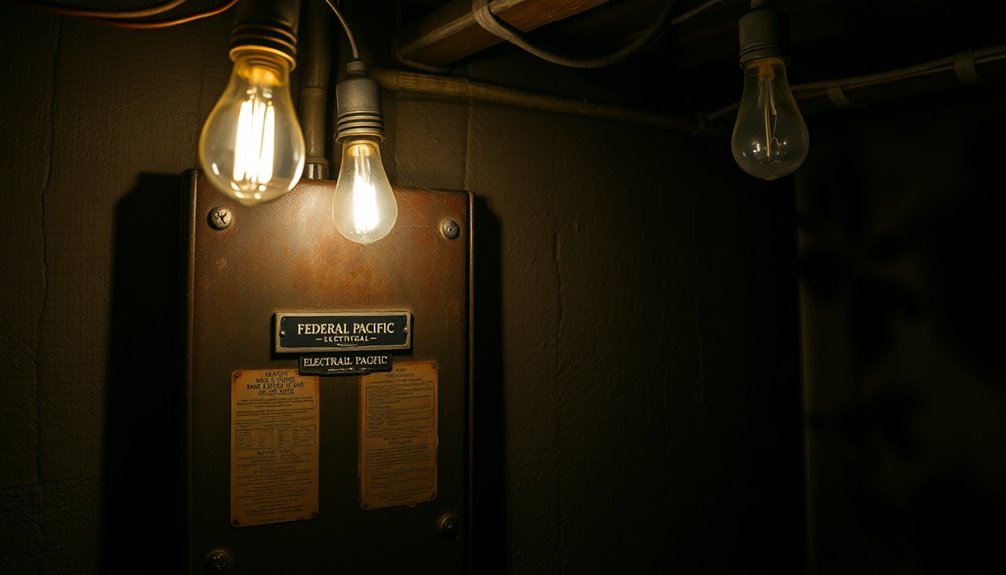
While many homeowners may not realize it, Federal Pacific Electric (FPE) panels significantly increase the risk of fire hazards in their homes. Each year, these panels cause around 2,800 fires, primarily due to circuit breakers that fail to trip during electrical faults. When breakers don't trip, wiring overheats, leading to potentially devastating fires that can result in property damage and loss of life. Homes equipped with FPE panels are much more susceptible to electrical fires compared to those with modern panels.
Statistics reveal the severity of this issue—FPE panel failures contribute to about 13 deaths annually and cause an estimated $40 million in property damage. With around 28 million FPE Stab-Lok breakers still in use, many homes are at risk due to these devices failing to provide adequate fire protection. The compact design of FPE panels often prevents compliance with safety standards, further increasing fire hazards. Moreover, investigations by the Consumer Product Safety Commission identified over a 50% failure rate in FPE breakers, highlighting the urgent need for replacements.
To protect yourself and your family, consider replacing these outdated panels with safer, modern alternatives. Professional inspections can help identify potential dangers and ensure your electrical system meets current safety standards, greatly reducing the risk of fire.
Regulatory Status and Insurance

Understanding the regulatory status of Federal Pacific Electric (FPE) panels is crucial for homeowners who may unknowingly put their properties at risk. The Consumer Product Safety Commission (CPSC) investigated FPE circuit breakers from 1980 to 1983 and found they didn't fully comply with Underwriters Laboratories (UL) requirements. Although the CPSC didn't make definitive safety claims, these panels don't meet modern building codes, which can complicate real estate transactions or home inspections.
From an insurance perspective, many companies consider FPE panels high-risk. They may refuse coverage or demand higher premiums, and some might even require you to replace the panels before granting or continuing coverage. Specialized insurance is available, but it often comes with a hefty price tag and isn't widely offered. The increased risk of electrical fires and safety hazards associated with FPE panels drives these high premiums. Additionally, insurers may charge higher premiums for homes with specific circuit breaker models due to the associated risks.
Ultimately, homeowners might face significant financial burdens due to elevated insurance costs or the expense of replacing FPE panels, which can run around $1,500. It's essential to weigh these implications carefully and consider your options.
Identifying FPE Panels

To identify Federal Pacific Electric (FPE) panels, start by examining the breaker box for specific labels and branding. Look for the inscription "Federal Pacific Electric" on the cover or check for the brand name "FPE" or "Federal Pacific" inside the panel. You might also see variations such as "Federal Electric" or "Federal Pioneer." A key identifier is the presence of "Stab-Lok," which refers to the unique design of the breakers.
Next, focus on the breakers themselves. FPE Stab-Lok breakers feature a distinctive "stab" design, with a red stripe across each switch. Unlike other breakers, they use toggle switches that often have a red face. If you see this setup, you're likely dealing with an FPE panel. It is essential to note that all FPE equipment has known safety issues, which can lead to increased fire hazards.
Consider the age of your home, as FPE panels were commonly installed between the 1950s and 1980s. If your home was built during this period, it's more likely to have FPE equipment. For further clarity, refer to photo guides that showcase FPE Stab-Lok panels and breakers, ensuring you can spot these specific features easily.
Inspection and Professional Help

When it comes to ensuring your home's safety, inspecting your electrical panel is crucial, especially if you suspect you have a Federal Pacific Electric (FPE) panel. FPE panels are flagged as major safety concerns during home inspections due to their high failure rates and associated fire risks. Inspectors will likely recommend replacement, as these panels are tied to approximately 2,800 fires annually, leading to tragic consequences and significant property damage.
If an inspector identifies an FPE panel, they'll suggest a thorough examination by a licensed electrician. It's essential to act quickly, as the presence of an FPE panel can hinder mortgage approvals and insurance coverage. Remember, it's illegal for electricians to install new FPE panels, given their failure to meet modern safety standards.
In fact, the estimated failure rate of FPE panels is around 33%, which underscores the urgency for homeowners. Professional recommendations are clear: replacing an FPE panel is the safest option to mitigate potential hazards. Don't delay in contacting a licensed electrician to assess your situation. Ensuring your home's electrical system meets current safety regulations is vital for your peace of mind and the safety of your loved ones. Prioritize this inspection and take action to protect your home today.
Replacement Options and Costs
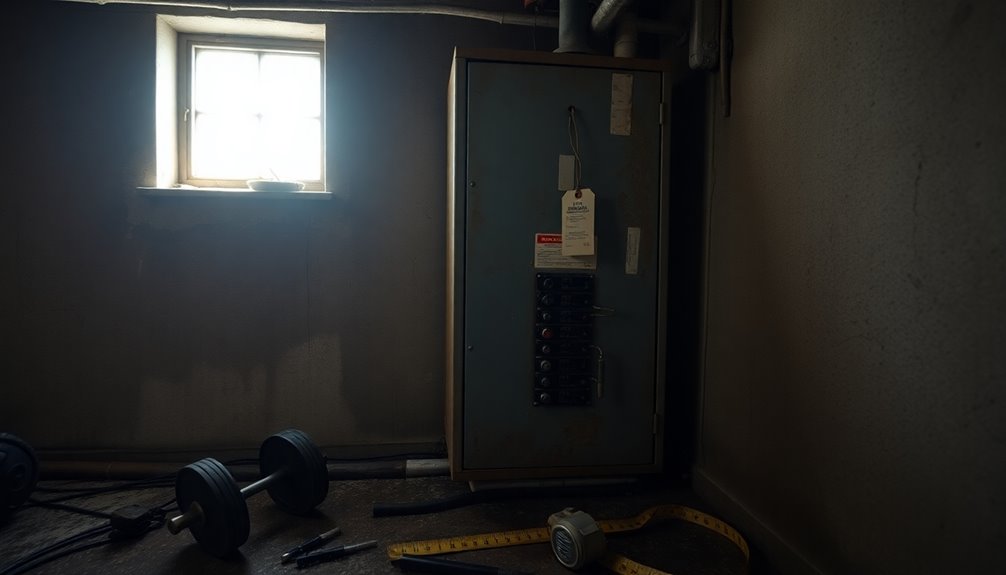
Replacing a Federal Pacific Electric panel is a crucial step in ensuring your home's safety and compliance with modern electrical standards. You have several replacement options to consider, including Connecticut Electric Circuit Breakers, which are UL-approved and competitively priced. Siemens Electrical Panels are also worth considering for their quality engineering and advanced safety features. Square D Panels are known for their durability, while Eaton/Cutler-Hammer Panels meet strict industry standards. Leviton Load Centers offer customizable configurations with built-in safety features.
When selecting a replacement, ensure the panel matches your home's amperage needs, typically around 200 amps for residential use, and is compatible with your existing wiring. Look for panels that include AFCI and GFCI breakers for added protection against electrical hazards. Additionally, replacing Federal Pacific panels is often recommended due to their associated safety risks with failing circuit breakers.
Replacement costs generally range around $1,500, but this can vary based on your specific situation. Keep in mind that maintaining a Federal Pacific panel may lead to higher insurance premiums, so compare the cost of replacement to potential financial losses from increased insurance rates. Getting quotes from licensed contractors will help you budget accurately, while long-term savings on safety and reliability can make the investment worthwhile.
Maintenance and Safety Measures

Regular maintenance and safety measures are essential for managing the risks associated with Federal Pacific Electric panels. If your home was built between 1950 and 1990, you likely have one of these panels. Start by checking for Stab-Lok breakers, a common sign of Federal Pacific panels. Inspect the circuit breaker panel for the manufacturer's label, and if you're unsure, hire a qualified electrician to confirm the type of panel.
Stab-Lok breakers are known to overheat and malfunction, with a high failure rate under UL 489 test conditions. This isn't just a minor concern—estimates suggest that these panels contribute to thousands of residential electrical fires each year. Proactive maintenance is crucial, but it won't eliminate the risks completely. Never attempt to repair an FPE panel yourself; the dangers are too high. Additionally, up to 25% of Zinsco breakers may fail when needed, highlighting the importance of vigilance in your electrical system.
It's best to schedule regular inspections with certified electricians. They can recommend necessary actions, including replacing the entire panel with a modern, compliant circuit breaker panel. Insurance companies often deem FPE panels unacceptable, so don't wait—ensure your home's safety today.
Long-term Implications for Homeowners

The risks associated with Federal Pacific Electric (FPE) panels extend beyond immediate safety concerns; they carry significant long-term implications for homeowners. First, FPE panels don't meet current National Electric Code (NEC) requirements, making them non-compliant and potentially illegal for installation in new homes. Insurance companies often classify these panels as high-risk, resulting in higher premiums or even denied coverage, which can strain your finances.
Additionally, if you're considering selling your home, the presence of an FPE panel can negatively affect your property's resale value. Homebuyers may be deterred by safety concerns and the potential costs of replacing outdated panels. If a home inspection reveals an FPE panel, it could complicate or derail the sale entirely. Furthermore, the CPSC investigation into FPE panels revealed that many of these breakers failed to trip during safety tests, which adds to buyer hesitance.
With FPE panels linked to an estimated 2,800 fires annually, the stakes are high. The potential for property damage and increased insurance costs can lead to significant financial burdens. Upgrading to a modern panel not only enhances safety but also boosts your home's marketability and value. In the long run, addressing the FPE panel issue sooner rather than later can save you from costly repercussions.
Frequently Asked Questions
Can I Sell My Home With a Federal Pacific Panel Installed?
You can sell your home with a Federal Pacific panel installed, but it might be challenging. Many buyers see these panels as a red flag, leading to lower offers or demands for repairs. Home inspectors often recommend replacement, and insurance companies may refuse coverage, complicating the sale. To attract buyers and ensure safety, consider replacing the panel beforehand. Consulting a qualified electrician is a smart move to discuss your options.
What Should I Do if I Find an FPE Panel?
If you find an FPE panel in your home, don't ignore it. First, hire a qualified electrician to assess its condition and safety risks. It's crucial to consider replacing the entire panel, as the breakers are known to fail and pose serious fire hazards. Avoid attempting any repairs yourself; that could lead to more dangers. Remember, safety should always come first, so take action promptly to protect your home and family.
Are FPE Panels Safe if They Haven't Malfunctioned Yet?
Even if your FPE panel hasn't malfunctioned yet, it's not safe. These panels are known for their high failure rates, with many breakers failing to trip during electrical faults, leading to potential fires. Just because it seems to be working fine doesn't mean it won't pose a risk. It's best to consult a professional and consider upgrading to a modern panel to ensure your home's safety and meet current standards.
How Can I Dispose of an Old FPE Panel?
To dispose of an old FPE panel, start by removing it safely with a licensed electrician. Make sure all breakers and wiring are disconnected. You'll want to check local regulations for disposal, as these panels aren't typically hazardous unless they contain specific materials. Consider recycling any metal components. If the panel has hazardous materials, use a registered waste transporter and ensure proper containment during transportation to an approved facility. Keep records for compliance.
Do All Homes Built Before 1980 Have FPE Panels?
Not all homes built before 1980 have FPE panels. While many homes constructed between the 1950s and 1980s may feature these panels due to their popularity, other manufacturers supplied electrical panels during that time. If you're unsure about your panel, take a look at the circuit breaker. You might spot Stab-Lok breakers or other identifying features. If it's still unclear, consider having a qualified electrician inspect it for you.
Conclusion
In conclusion, if you've got a Federal Pacific Electric panel in your home, it's crucial to take action. These panels pose significant safety risks that could endanger your family and property. Don't ignore potential hazards; consider getting your panel inspected by a professional. Replacing it might seem costly, but the peace of mind and safety it brings are invaluable. Stay proactive about your home's electrical system and protect what matters most.
